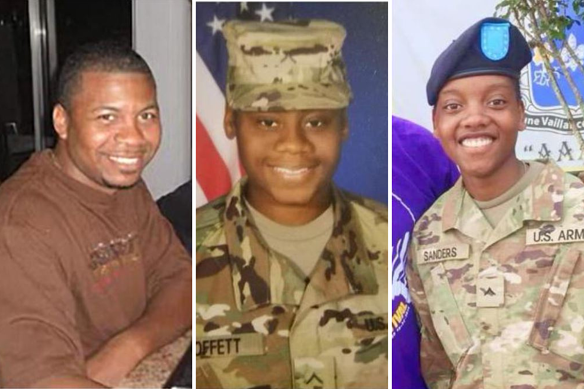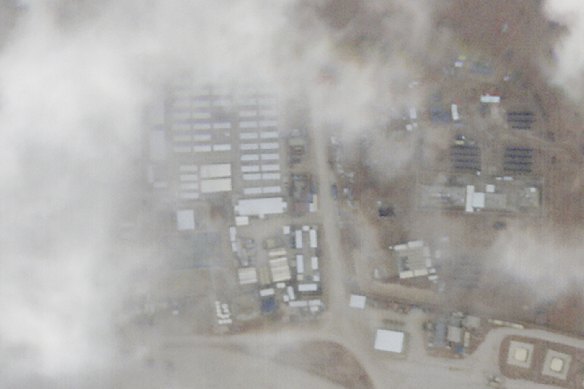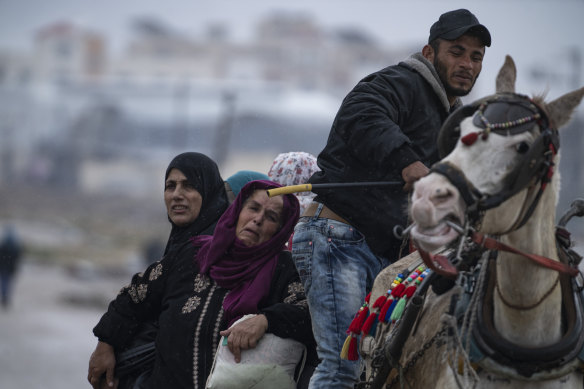This was published 1 year ago
Drone that killed US troops may have been allowed to pass by mistake
By Lolita Baldor and Zeke Miller
Washington: US forces may have mistaken an enemy drone for an American one and let it pass unchallenged into a desert base in Jordan where it killed three US troops and wounded dozens more, officials say.
Details of the attack emerged as US President Joe Biden faced a difficult balancing act, blaming Iran and looking to strike back in a forceful way without causing any further escalation of the Gaza conflict.

The killed soldiers (from left): Sergeant William Jerome Rivers, Specialist Breonna Alexsondria Moffett and Specialist Kennedy Ladon Sanders.Credit: US Defence Department
As the enemy drone was flying in at a low altitude, a US drone was returning to the small installation known as Tower 22, according to a preliminary report cited by two officials, who were not authorised to comment and insisted on anonymity.
As a result, there was no effort to shoot down the enemy drone that hit the outpost. One of the trailers where troops sleep sustained the brunt of the strike, while surrounding trailers got limited damage from the blast and flying debris.
Aside from the soldiers killed, the Pentagon said more than 40 troops were wounded in the attack, most with cuts, bruises, brain injuries and similar wounds. Eight were medically evacuated, including three who were going to Landstuhl Regional Medical Centre in Germany. The other five, who suffered minor brain injuries, were expected to return to duty.
The preliminary conclusion was first reported by The Wall Street Journal.

A satellite photo from Planet Labs PBC shows a military base known as Tower 22 in northeastern Jordan on Monday.Credit: AP
Asked if the failure to shoot down the enemy drone was “human error,” Pentagon spokeswoman Sabrina Singh responded that the US Central Command was still assessing the matter.
The Pentagon identified those killed in the attack as Sergeant William Jerome Rivers, 46, Specialist Kennedy Ladon Sanders, 24, and Specialist Breonna Alexsondria Moffett, 23.
The explanation for how the enemy drone evaded US air defences came as the White House said it’s not looking for war with Iran even as Biden vows retaliatory action. The administration believes Tehran was behind the strike.
Biden met with national security advisers in the White House Situation Room to discuss the latest developments and potential retaliation.
“There’s no easy answer here,” said National Security Council spokesman John Kirby. “And that’s why the president is meeting with his national security team weighing the options before him.”
The brazen attack, which the Biden administration blames on Iranian-based proxies, adds another layer of complexity to an already tense Middle East situation as the Biden administration tries to keep the Israel-Hamas war from expanding into a broader regional conflict.
“The president and I will not tolerate attacks on US forces, and we will take all necessary actions to defend the US and our troops,” Defence Secretary Lloyd Austin said as he met at the Pentagon with NATO Secretary General Jens Stoltenberg.
Qatari Prime Minister Sheikh Mohammed bin Abdulrahman bin Jassim al Thani told a Washington think tank he hoped US retaliation would not undercut progress toward a new hostage release deal in talks last weekend.
CIA Director William Burns met Sheikh Mohammed, as well as the head of Israel’s Mossad intelligence service and the head of Egyptian intelligence, in Paris this week for talks described as constructive by Israel, Qatar and the US, albeit with significant gaps remaining.
US Secretary of State Antony Blinken said the Paris talks raised hope that a Qatar-mediated negotiating process could resume. Before collapsing, the mechanism led to a week-long ceasefire agreement in November when Hamas freed around 100 hostages.
Hamas reiterated overnight that Israel must halt its Gaza offensive and withdraw from the Gaza Strip before more hostages are freed. Israel says it will fight until Hamas is eradicated.
According to Israel, some 1200 people were killed and 253 abducted in the October 7 attack, which sparked its war to eliminate Hamas. Israel has since unleashed a military campaign on Gaza that has flattened most of the Palestinian enclave and killed 26,637 people, according to Gaza health officials.

Palestinians arrive in the southern Gaza town of Rafah after fleeing an Israeli ground and air offensive in the nearby city of Khan Younis.Credit: AP
On Monday, Hamas fired its first volley of rockets for weeks into Israeli cities, proving it still had the capability to launch them after nearly four months of war.
Gazans say the violence has made a mockery of a World Court ruling last week calling on Israel to do more to help civilians.
Israel ordered new evacuations of the most populated areas of Gaza City, but people said communications blackouts meant many would miss the alerts. Israel says Hamas is responsible for the deaths of civilians because its fighters operate among them, which the fighters deny.
People in the north have been grinding animal feed to make flour after flour, rice and sugar ran out, part of an aid crisis now potentially exacerbated by a withdrawal of support for the United Nations’ aid agency for Palestinian refugees, UNRWA.
AP, Reuters
Get a note directly from our foreign correspondents on what’s making headlines around the world. Sign up for the weekly What in the World newsletter here.